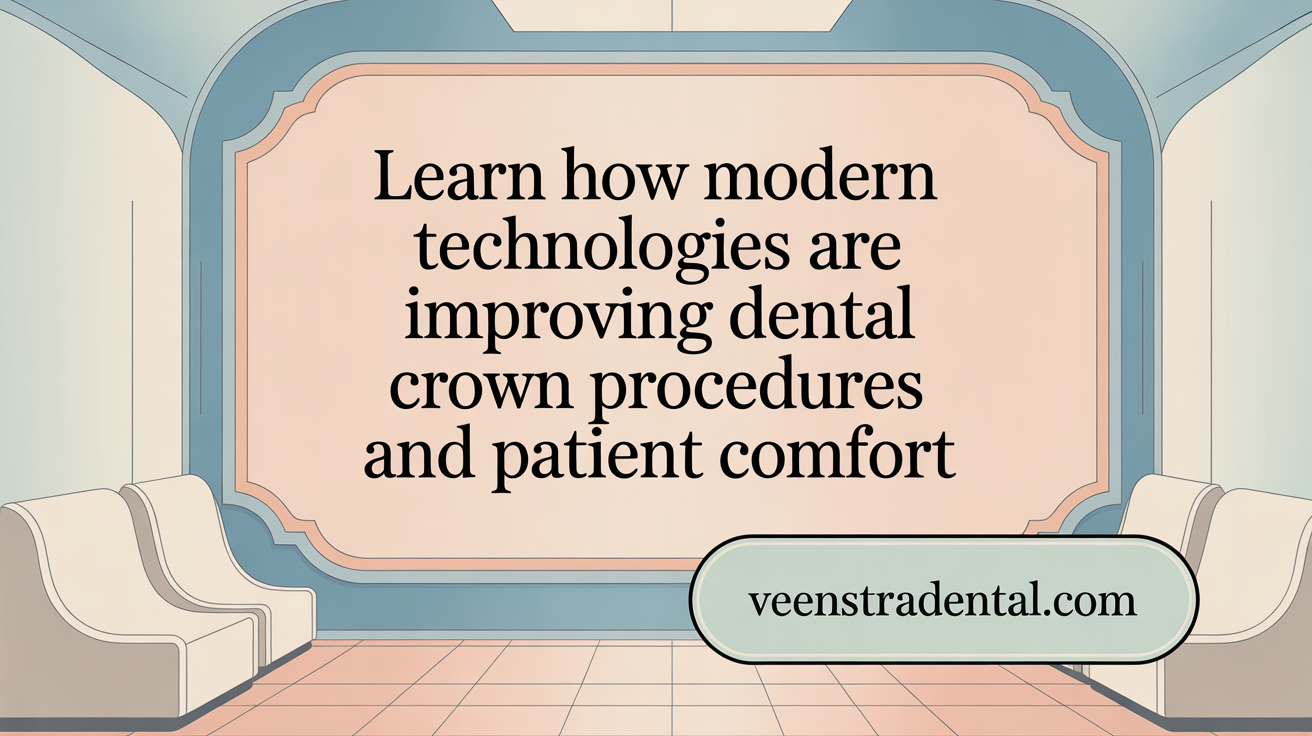Understanding Dental Crowns and Their Purpose
Dental crowns play a pivotal role in restoring damaged or missing teeth by providing strength, protection, and a natural appearance. This article explores how advancements in dental technology, especially the emergence of same-day crown procedures, have transformed the experience of repairing smiles, making it quicker and more convenient than ever before.
What Are Dental Crowns and Why Are They Essential for Smile Restoration?

What are dental crowns and how do they restore damaged or missing teeth?
Dental crowns are custom-made coverings that fit over a damaged or decayed tooth. They are designed to restore the tooth’s shape, size, strength, and appearance, ultimately improving both function and aesthetics.
Made from various materials such as porcelain, gold, or ceramic composites like E-Max, crowns are crafted to match the natural color of your teeth, providing a seamless look. They cover the entire visible part of a tooth from the gum line to the top surface.
Crowns are used in numerous dental situations. They protect teeth severely damaged by decay or trauma, strengthen teeth that have undergone root canal treatment, and support dental restorations like bridges and implants. Besides restoring function, they also improve the appearance of misshapen, discolored, or cosmetically imperfect teeth.
The placement process involves removing a small amount of enamel from the damaged tooth, taking precise impressions or digital scans, and then fabricating the crown. Once ready, the crown is cemented firmly onto the prepared tooth.
Thanks to advancements like CEREC technology, same-day crowns can be created and fitted within a single appointment. This quick process typically takes about 2-3 hours and avoids the inconvenience of temporary crowns and multiple visits.
Proper care, including brushing, flossing, and regular dental check-ups, can ensure that dental crowns last for 10-15 years or longer. They provide durable, functional, and aesthetically pleasing restorations that safeguard your natural teeth and enhance your smile.
How Crowns Help Restore Teeth Damaged by Decay, Trauma, or Root Canals
Crowns are often the final step after procedures like root canals, where they reinforce the compromised tooth structure. They also serve to prevent tooth extraction in cases of severe damage or decay, maintaining the natural bite and preventing shifting of neighboring teeth.
In summary, dental crowns play a vital role in preserving tooth health, restoring appearances, and supporting overall oral function, making them an essential option for comprehensive dental care.
Benefits of Dental Crowns: Health, Function, and Aesthetics
What are the benefits of dental crowns for dental health and aesthetics?
Dental crowns provide many advantages for both the health and appearance of your teeth. They restore the strength and functionality of teeth that have been damaged, decayed, or broken, often lasting 10 to 15 years or more when properly maintained.
Crowns serve as protective caps that prevent further decay and damage, reducing future dental issues. They also help in maintaining a correct bite and preventing shifting of surrounding teeth, which can lead to misalignment.
Aesthetic improvements are another significant benefit. Crowns can conceal discoloration, misshapen, or crooked teeth, giving you a more attractive smile. They are custom-designed to match the natural color and shape of your teeth, boosting your confidence.
In addition, dental crowns are essential in supporting dental implants and reinforcing weakened teeth, especially after procedures like root canals. They offer a durable, long-term solution that can improve your overall oral health and stability.
Overall, crowns protect your teeth, enhance your smile, and help ensure your dental function remains strong for years to come.
Traditional vs. Same-Day Dental Crown Procedures: A Comparison

What is the process involved in getting dental crowns, including traditional and same-day options?
Getting a dental crown can vary significantly depending on whether you choose a traditional method or a modern, same-day procedure.
Traditional Process: The conventional approach usually involves multiple visits over a span of 2-3 weeks. During the initial appointment, the dentist numbs the tooth with local anesthesia and prepares it by removing a small amount of tooth structure to make space for the crown. Impressions of your teeth are then taken either with traditional molds or digital scans. These impressions are sent to a dental lab where your custom-made crown is fabricated from various materials like porcelain, gold, or zirconia. To protect the tooth in the meantime, a temporary crown is placed.
After about 1-2 weeks, you return to your dentist to have the temporary crown removed and the permanent crown cemented onto your tooth. This process ensures a precise fit and aesthetic matching but requires multiple visits and temporary restorations.
Same-Day Process Using CEREC Technology: The modern alternative employs advanced digital tools like CAD/CAM (Computer-Aided Design and Computer-Aided Manufacturing) technology. First, the dentist uses a special camera to take a digital impression of your tooth, which is faster and more comfortable than traditional molds. This digital data is uploaded to a computer where the crown is designed virtually.
Next, a milling machine fabricates the crown from a ceramic block within the dental office, a process typically taking around 15-20 minutes. Once milled, the crown is checked for fit and then bonded to your tooth in the same appointment.
Time and Convenience Differences
The traditional process often involves two or more visits, temporary crowns, and a waiting period of one to two weeks. It also requires extra care with temporary crowns to prevent damage or displacement.
In contrast, same-day crowns like those made with CEREC technology allow patients to complete the entire procedure in just one visit, usually within 2-3 hours. This not only saves time but also enhances convenience and reduces overall discomfort.
Temporary Crowns and Impressions
Traditional crowns necessitate taking physical impressions, which can be uncomfortable, and require a temporary crown to protect the tooth during the interim. These temporary restorations can sometimes be fragile or feel uncomfortable.
Conversely, digital impressions used in same-day crowns improve accuracy and comfort, eliminating the need for messy molds and temporary crowns. The result is a faster, more comfortable experience, often with better fitting restorations.
| Aspect | Traditional Crown Procedure | Same-Day Crown Procedure | Notable Differences |
|---|---|---|---|
| Appointments Needed | 2-3 | 1 | Time and convenience |
| Impression Type | Physical molds | Digital scans | Comfort and accuracy |
| Fabrication Time | 1-2 weeks | 15-20 minutes | Speed of process |
| Temporary Crown | Usually required | Not required | Temporary vs. permanent |
| Overall Time | Several weeks | About 1-3 hours | Efficiency |
Exploring Dental Crown Materials and Provider Considerations

What types of dental crowns are available, such as CEREC crowns and implant crowns, and how do they compare?
There are several kinds of dental crowns tailored to different needs and preferences. CEREC crowns are modern, same-day solutions created directly in the dental office using advanced CAD/CAM technology. These crowns are fabricated from ceramic materials and can be designed, milled, and placed within a single appointment, often taking just 90 minutes.
Traditional crowns, on the other hand, involve multiple visits. They are usually made in dental laboratories from materials like porcelain fused to metal (PFM), pure porcelain, or other ceramics. This process often includes taking impressions, fabricating the crown over a week or two, and fitting a temporary crown in the meantime.
Specialized implant crowns are designed for missing teeth, attaching to dental implants that are surgically placed into the jawbone. These crowns restore function and appearance for patients with missing teeth and are typically custom-made with durable materials.
While CEREC crowns offer swift, precise, and aesthetic restorations, traditional crowns can provide a broader range of materials and customization options. Implant crowns are specific to cases involving tooth replacement, ensuring stability and durability. The choice among these options depends on the patient’s dental needs, time constraints, and aesthetic desires.
What factors should be considered when choosing dental crown materials and providers?
Selecting the right crown material and provider involves evaluating multiple factors. Durability is essential; materials like gold or zirconia offer great strength for molars subjected to chewing forces, whereas porcelain and E-Max ceramics excel in aesthetic appeal, making them ideal for front teeth.
Cost is another consideration. Gold and zirconia crowns tend to be more expensive but last longer, while porcelain options may be more affordable but sometimes less durable.
The location of the tooth influences material choice. For visible front teeth, natural-looking porcelain or E-Max crowns are preferred, while rear teeth withstand more force and benefit from stronger materials.
The dental provider’s expertise also plays a vital role. Practices equipped with modern technology like CAD/CAM systems for same-day crowns can deliver high-quality, precise restorations efficiently. Moreover, an experienced dentist familiar with different crown materials ensures optimal fit, function, and aesthetics.
Ultimately, a thorough consultation helps balance aesthetic goals, functional needs, budget, and health considerations. Trusted providers who utilize advanced technology and have a good track record can significantly impact the longevity and success of a dental crown.
More Information
Searching for "dental crown materials and provider selection guidance" can provide further insights on how to choose the most appropriate options for individual needs, emphasizing the importance of professional advice tailored to your specific dental situation.
Maintaining Your Dental Crowns for Long-Lasting Smiles
How long do dental crowns last and what maintenance is required?
Dental crowns are a durable solution for restoring damaged teeth, with an average lifespan of 5 to 15 years. However, some crowns can last over 20 years with proper care. The longevity of a crown depends on factors such as the material used—common options include porcelain, zirconia, and gold—as well as the location of the tooth and daily oral habits. To ensure your crowns stay in top condition, maintaining excellent oral hygiene is essential. Brush twice daily with a soft-bristled toothbrush, floss regularly, and schedule routine dental checkups. Avoid chewing on hard foods like ice or sticky candies that could chip or dislodge the crown. If you grind your teeth at night, consider wearing a custom night guard to prevent damage. Watch for signs like staining, chips, looseness, or discomfort, which could indicate the need for replacement or repair. Regular dental visits can catch early issues and help prolong the life of your crowns.
Why Same-Day Dental Crowns Are the Future of Smile Restoration
Embracing modern dental innovation, same-day crowns offer patients a fast, precise, and convenient way to restore damaged teeth without the traditional wait or discomfort. Combining aesthetic excellence with durable materials and expert care, these crowns enhance smile restoration like never before. Whether addressing sensitivity from decay, repairing teeth after root canals, or improving cosmetic appearance, quick dental crowns deliver lasting results. With proper maintenance, these restorations can protect and beautify your smile for years, making the process of recovering oral health and confidence easier and more accessible than ever.
References
- Same Day Dental Crowns Can Restore Your Smile
- Dental Crowns in Evergreen Park, IL
- Restore Your Smile With Dental Crowns: What You Should Know
- CEREC Same-Day Crowns: Get a New Crown in a Single Day
- Natural-Looking Dental Crowns Orlando FL - Restore Your Smile
- CEREC Crown Procedure: Same Day Dental Crowns in Hamden, CT
- Dentist Material Selection for Single-Unit Crowns - PubMed Central
- How to Choose the Right Material for Your Dental Crown
- Dental Crowns: Types, Procedure & Care - Cleveland Clinic
- Choosing the Best Dental Crown: A Comprehensive Guide
